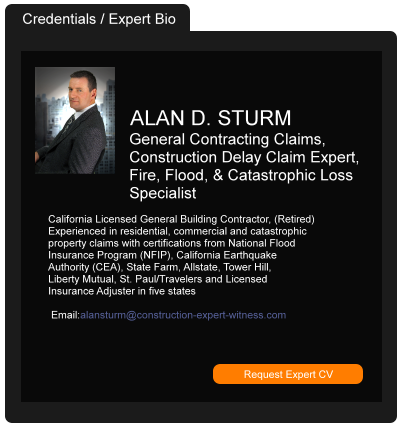Read Carefully. The Insurance Coverage You Thought You Were Getting May Not Be The Coverage You Got
November 27, 2013 —
Bret Cogdill — Higgins, Hopkins, McLain & Roswell, LLCA recent U.S. District Court case in Colorado highlighted the importance for an insured to read and understand the terms of its insurance policy. The case 2-BT, LLC v. Preferred Contractors Insurance Company Risk Retention Group, LLC, Civil Action No. 12CV02167PAB, was a controversy between an insured’s expectations for coverage, and the terms and exclusions of the insurance policy.
2-BT is a heating, ventilation, and air-conditioning (“HVAC”) contractor, which utilizes soldering devices and heat sources among other tools for its trade. 2-BT needed liability insurance to cover its work, and found a provider, Preferred Contractors Insurance Company Risk Retention Group, LLC (“PCIC”). 2-BT read PCIC’s online materials, which stated “PCIC’s personalized underwriting process allows us to tailor coverage to properly outfit the contractor with excellent coverage and rates.”
2-BT filled out a policy application, which included a description of the type of HVAC work it performs, initialed several sections, and signed it. One of the initialed paragraphs on the application, “Policy Exclusions,” stated that damages arising from “fungi/bacteria,” “open flame,” and “use of heating devices,” was not covered. PCIC issued a policy to 2-BT, which included a section titled, “Additional Exclusions” that excluded coverage for mold and damage related to heating elements among others.
Read the court decisionRead the full story...Reprinted courtesy of
Bret CogdillBret Cogdill can be contacted at
cogdill@hhmrlaw.com
Construction Law Alert: Appellate Court Lets Broad General Release Stand in SB 800 Case
February 26, 2015 —
Steven M. Cvitanovic and Colin T. Murphy – Haight Brown & Bonesteel LLPUnder California's SB 800 "Right to Repair Act," a builder may obtain a "reasonable release" to resolve a construction defect claim in exchange for a cash payment. So, what's a "reasonable release" under SB 800? This question was answered by the Second Appellate District in the case of Belasco v. Wells (filed 2/17/2015, No. B254525).
Plaintiff David Belasco ("Plaintiff") purchased a newly constructed residence in 2004 from the builder defendant Gary Loren Wells ("Wells"). In 2006, Plaintiff filed a complaint against Wells with the Contractors' State License Board (the "Board") regarding certain alleged construction defects. The parties settled the 2006 action through written agreement that required Wells to pay Plaintiff $25,000 in consideration for Plaintiff executing a release and a Civil Code §1524 waiver of all known or unknown claims. In 2012, Plaintiff filed a subsequent action against Wells and Wells’ surety, American Contractors Indemnity Company ("American Contractors") (collectively "Defendants"), alleging a defect in the roof that was discovered by Plaintiff in 2011.
Reprinted courtesy of
Steven M. Cvitanovic, Haight Brown & Bonesteel LLP and
Colin T. Murphy, Haight Brown & Bonesteel LLP
Mr. Cvitanovic may be contacted at scvitanovic@hbblaw.com
Mr. Murphy may be contacted at cmurphy@hbblaw.com
Read the court decisionRead the full story...Reprinted courtesy of
NY Construction Safety Firm Falsely Certified Workers, Says Manhattan DA
March 25, 2024 —
Johanna Knapschaefer - Engineering News-RecordA New York-based construction safety firm and 25 individuals were indicted Feb. 28 for allegedly operating a bogus safety training school, Manhattan District Attorney Alvin Bragg's office says. The firm, Valor Security & Investigations is also linked to “endangering the life” of Ivan Frias, who fell to his death from the 15th floor of a New York City construction site in 2022.
Reprinted courtesy of
Johanna Knapschaefer, Engineering News-Record
Ms. Knapschaefer may be contacted at knapj@enr.com
Read the full story... Read the court decisionRead the full story...Reprinted courtesy of
CDJ’s #5 Topic of the Year: Beacon Residential Community Association v. Skidmore, Owings & Merrill, et al.
December 31, 2014 —
Beverley BevenFlorez-CDJ STAFFSteven M. Cvitanovic and Whitney L. Stefko of Haight Brown & Bonesteel analyzed the Beacon decision, and discussed how it affects developers and general contractors: “On July 3, 2014, the California Supreme Court (the “Court”) came out with its decision in Beacon Residential Community Association v. Skidmore, Owings & Merrill, et al. The Beacon decision settled a long-standing dispute in California about whether design professionals such as architects and engineers owe a duty to non-client third parties. In finding that the plaintiffs in Beacon could state a claim against the architects of the Beacon project, the Court also sowed the seeds of change in the way contracts are structured between developers, architects, engineers, and even general contractors.”
Read the court decisionRead the full story...Reprinted courtesy of
Luxury Homes Push City’s Building Permits Past $7.5 Million
December 30, 2013 —
CDJ STAFFThe city of Ardmore, Oklahoma is seeing a building boom with the total value of building permits issued by the city in November slightly exceeded $7.5 million, reports Ardmoreite.com. Most of that total comes from residential construction, with the bulk of it coming from just three homes. While Lance Windel Construction plans on building 46 homes, the top value of those homes will be $153,000. The total value for the homes being built by three other firms is more $6.4 million, and those contractors are building just one home each.
Read the court decisionRead the full story...Reprinted courtesy of
I.M. Pei, Architect Who Designed Louvre Pyramid, Dies at 102
July 01, 2019 —
James S. Russell - BloombergI.M. Pei, a dominant figure in American architecture for more than three decades who designed the Louvre’s crystal pyramid and the angular East Building of Washington’s National Gallery of Art, has died. He was 102.
His son Li Chung Pei said on Thursday that his father had died overnight, the New York Times reported.
Pei gave “this century some of its most beautiful interior spaces and exterior forms,” said the jury of the Pritzker Architecture Prize, which Pei won in 1983.
Though reserved and supremely diplomatic, Pei’s face, always crowned by round thick-rimmed glasses, could break unexpectedly into a wide, dazzling smile. He approached clients with charm and a quick wit, and they usually succumbed happily.
Read the court decisionRead the full story...Reprinted courtesy of
James S. Russell, Bloomberg
CA Supreme Court Permits Insurers to Bring Direct Actions Seeking Reimbursement of Excessive Fees Against Cumis Counsel Under Limited Circumstances
August 19, 2015 —
David W. Evans & Valerie A. Moore – Haight Brown & Bonesteel LLPThe California Supreme Court held in Hartford Casualty Insurance Company v. J.R. Marketing, L.L.C. (Squire Sanders) (8/10/2015 - #S211645) that if Cumis counsel, operating under a court order which such counsel drafted and which expressly provided that the insurer would be able to recover excessive fees, sought and received fee payments from the insurer that were fraudulent or otherwise manifestly and objectively useless and wasteful when incurred, Cumis counsel have been unjustly enriched at the insurer’s expense and the insurer will be permitted under such limited circumstances to seek reimbursement directly from Cumis counsel.
Certain Hartford insureds who had been issued commercial general liability policies were sued in multiple proceedings for a variety of claims, including unfair competition, defamation and intentional misrepresentation. Hartford disclaimed a duty to defend or to indemnify the defendants on the grounds that the acts complained of occurred prior to Hartford’s policy, and that some of the defendants were not Hartford insureds. A coverage action was filed by some of the insureds against Hartford; they were represented by the Squire Sanders law firm. Although Hartford subsequently agreed to defend several of the defendants subject to a reservation of rights, it declined to pay defense expenses incurred prior to the date of such agreement. Some months later, the trial court entered a summary adjudication order, finding that Hartford had a duty to have defended the liability action on the date it was originally tendered; the order required Hartford to fund the insured’s defense with independent counsel (i.e., so-called “Cumis” counsel; see San Diego Federal Credit Union v. Cumis Insurance Society, Inc. (1984) 162 Cal.App.3d 358). The insureds retained Squire Sanders as their Cumis counsel.
Reprinted courtesy of
David W. Evans, Haight Brown & Bonesteel LLP and
Valerie A. Moore, Haight Brown & Bonesteel LLP
Mr. Evans may be contacted at devans@hbblaw.com
Ms. Moore may be contacted at vmoore@hbblaw.com
Read the court decisionRead the full story...Reprinted courtesy of
Dangerous Condition, Dangerous Precedent: California Supreme Court Expands Scope of Dangerous Condition Liability Involving Third Party Negligent/Criminal Conduct
August 19, 2015 —
R. Bryan Martin, Laura C. Williams, & Lawrence S. Zucker II – Haight Brown & Bonesteel LLPIn Cordova v. City of Los Angeles (filed 8/13/15, Case No. S208130), the California Supreme Court held a government entity is not categorically immune from liability where the plaintiff alleges a dangerous condition of public property caused the plaintiff’s injury, but did not cause the third party conduct which precipitated the accident.
The case arises out of a traffic collision by which the negligent driving of a third party motorist caused another car to careen into a tree planted in the center median owned and maintained by the City of Los Angeles (“City”). Of the four occupants in the car that collided with the tree, three died and the fourth was badly injured. The parents of two of the occupants sued the City for a dangerous condition of public property under Government Code Section 835. The plaintiffs alleged the roadway was in a dangerous condition because the trees in the median were too close to the traveling portion of the road, posing an unreasonable risk of harm to motorists who might lose control of their vehicles.
The City successfully moved for summary judgment, which plaintiffs appealed. On review, the Court of Appeal affirmed holding the tree was not a dangerous condition as a matter of law because there was no evidence that the tree had contributed to the criminally negligent driving of the third party motorist.
Reprinted courtesy of Haight Brown & Bonesteel LLP attorneys
R. Bryan Martin,
Laura C. Williams and
Lawrence S. Zucker II
Mr. Martin may be contacted at bmartin@hbblaw.com
Ms. Williams may be contacted at lwilliams@hbblaw.com
And Mr. Zucker may be contacted at lzucker@hbblaw.com
Read the court decisionRead the full story...Reprinted courtesy of


































































